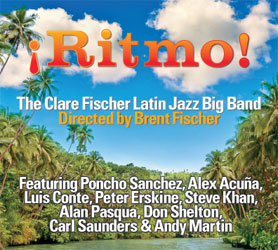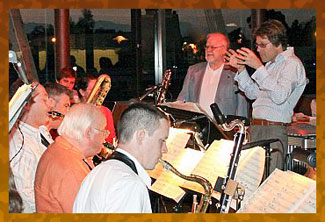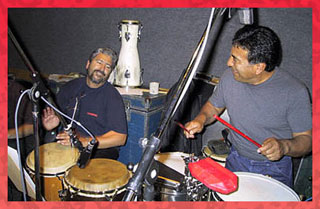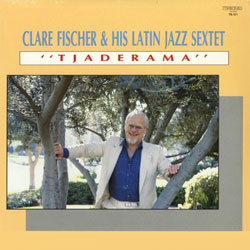

|
Soundclip:
|
| See Steve's Hand-Written Solo transcription |
|
Steve Khan's
solo on:  It was a particularly sad loss for the community of musicians, and all those who loved his playing, his compositions, and his arrangements. At that moment, I was also saddened that it seemed like the aforementioned project would now probably never happen. Of course, life is just that way sometimes. It was a particularly sad loss for the community of musicians, and all those who loved his playing, his compositions, and his arrangements. At that moment, I was also saddened that it seemed like the aforementioned project would now probably never happen. Of course, life is just that way sometimes.Then, just as suddenly, on May 29th, 2012, an e-mail arrived from Brent, the producer of the CD, and in the subject portion, it read: "Record with Clare Fischer Latin Jazz Big Band". Wow! I couldn't believe it, and couldn't wait to read the accompanying message. Attached to the e-mail was a vibes part for a tune titled, "San Francisco, P.M." and an mp3 of the original recording of the tune by Clare Fischer & His Latin Jazz Sextet from the LP, "TJADERAMA" from 1987. So, I listened and followed along with the lead sheet, and just fell in love with the tune right away. I could not believe my good fortune that I was going to get to become a part of Clare's recorded legacy and, on such a great, and uniquely Clare type of composition like this one. I replied to Brent immediately, and said that, "I'm all in!!!" Now, September of 2012 has arrived, and "¡RITMO!" by the Clare Fischer Latin Jazz Big Band was officially released. Not only had I never heard this great tune before, but I didn't even know that it had existed. It reminded that, no matter how much I think that I have learned about Clare's body of work, I have only just scratched the surface! In the correspondence that followed, Brent, who also did the very creative arrangement, explained to me that the concept was to retain the vibes, which had played the melody, mostly in 3rds, and then a flute would double the top voice, and the guitar would double the harmony voice below. This seemed like a good blend to me, and that my sound would fit very well. So, all I needed to do would be to play the written part an octave above so that the notes would sound where they were intended to sound. Of course, the biggest problem was going to be, how could I possibly get myself recorded for this in a 1st class, but inexpensive manner? And, there were time constraints too, as Brent wanted to release the finished CD in August of 2012. I immediately phoned my dear friend and trusted engineer, the great James Farber to see if he had any possible open dates in his schedule. At that moment, there were a few, but later in June looked best for him. The last possible open date for James was on June 28th! Then, just as suddenly, Brent wrote to tell me that he had to move the brass & reeds recording to June 25th, so he would not be able to have the engineer in Los Angeles send us the Pro-Tools files until that night, which meant that, at best, we would not receive them until June 26th! So, with only the 28th available for James, I then had to see if I could get into one of the small rooms at Avatar Studios, Studio 'G' seemed like a good option, but other clients were holding the time that day!!! Finally, we got lucky, and we would have from 10 A.M. to 2 P.M. to do all the work, and attempt to put together a nice rough mix to show Brent how I hoped the guitar would sound and fit into the textures. I just waited to hear from Brent as he began to assemble all the various players in Los Angeles to perform their parts. The one thing that Brent told me was that this interpretation was going to be a little bit slower than Clare's original performance. He decided, in the end, to bring it down about 10 metronome markings. From the arrival of the first demo, which had been sequencer and computer-driven, I began to formulate my approach to all the melodic sections for this [A]-[A2]-[B]-[A3] song form. The next demo that I received contained the performances of my dear friend, percussionist, Luis Conte, who, by the way, had performed on the original version! On this version, Luis played: timbal, bongo, campana, and maracas. He made the tune feel human, and his performance assured that now we would have the right sabor latino!!! That was hugely important to me. The next demo arrived, and suddenly, there was Rob Hardt's flute part. He did a beautiful job! Before Rob recorded, Brent had given me the option of soloing over [A]-[A2] or [B]-[A3]. I chose the first 1/2 of the chorus, because there was a nice solo break into [A] and that appealed to me. The last version I heard, before recording on the 28th of June, added in, another old and dear friend, Alex Acuña(drums), plus Quinn Johnson(Fender Rhodes), 5 trumpets, 4 trombones, and 5 reeds, and Brent on electric bass. As terrific as it all sounded, there was also a lot more space that had been filled, so I had to rethink things a bit to make sure that the presence of the electric guitar was going to fit, and fit well! Often times, the perception of the guitar, especially the electric guitar is that it is a high-register sounding instrument, when it is NOT at all! Most normal guitar playing in such a context finds the notes sitting right in the middle of the keyboard, and so much of Clare Fischer's brilliant harmonies are located right there. When it's an electric keyboard too, the sonority and texture of the instruments can be all too similar. So, as a guitarist, one really has to be careful.  I did not want to lose sight of my warm middle register by camping out in the upper register making myself a prisoner of that zone on the instrument. Fortunately, the solo reflects that I was able to do that. I did not want to lose sight of my warm middle register by camping out in the upper register making myself a prisoner of that zone on the instrument. Fortunately, the solo reflects that I was able to do that.What can make negotiating Clare Fischer's harmonies so tricky is that his voicing style allows for certain color tones to appear that would normally never be there. Let's take a look at the challenge of improvising over these 16-bar [A] sections. Obviously, they are filled with ii-Vs cadencing to m7th chords. In this case, Gm7b5 to C7(alt.) and finally resolving to Fm7. In bars 9-12 of each section, you face two similar, but non-resolving, ii-Vs. First, Bbm7b5 to Eb7(alt.), and then, Am7b5 to D7(alt.). What makes all the m7b5 chords so interesting is that tucked-in, in the middle of the keyboard voicings, is the natural 9th. So, on Gm7b5, you would see or hear an A-natural. Why is this unusual? Because, if you think carefully about it, and consider where you are headed, to resolve to Fm7, you have to realize that the m3rd of Fm7 is Ab, and prior to that, you are now playing an A-natural. Think about how that one note would sound ringing over into Fm7! This is why, where chord voicings are concerned, either 9th for a m7b5 chord is often avoided. Still, the correct mode to be playing over Gm7b5 would be Bb Dorian[Bb, C, Db, Eb, F, G, Ab]. Below, you can view how the 16-bar section and its chord changes might look. || Gm7b5 / / / | C7(alt.) / / / | Fm7 / / / | Bb7(9) / / / | | Gm7b5 / / / | C7(alt.) / / / | Fm7 / / / | Bb7(9) / / / | | Bbm7b5 / / / | Eb7b9(#5) / / / | Am7b5 / / / | D7b9(#5) / / / | | Gm7b5 / / / | C7(alt.) / / / | Fm7 / / / | Bb7(9) / / / || If you listen to the solo, and then, analyze what I happened to play each time the Gm7b5 chord appeared, it is interesting to note that the first 4 times, the only time that I played an Ab(the b9) over that chord was as a pick-up into the top of [A2]! However, in bars 5 and 13 of [A2], you see Ab's as part of an arpeggio, and as part of a descending modal line. It is no less interesting to note, that over the Bbm7b5 and the Am7b5, the two times that each chord appears in bars 9-12 of [A] & [A2], over the first chord you see no C-naturals played, nor any Cb's. Again, as I view things, I hear the chord Bbm7b5 with Db Dorian[Db, Eb, Fb, Gb, Ab, Bb, Cb] being played over it. Over the Am7b5, you never see any B-naturals played, nor any Bb's. Over that chord, the correct mode would be C Dorian[C, D, Eb, F, G, A, Bb]. Now, you might argue that in bar 9 of [A], I did play a Cb, and, in bar 11 of [A], I did play a Bb, but, I would tell you that those notes, in that context, are really part of the altered dominant 7th chord that is coming in the next bar. Let us now address the issue of an altered dominant 7th chord as it passes to resolution on a minor 7th chord, that as opposed to a major 7th chord, or a consonant dominant 7th chord. Generally speaking, when improvising, especially over a chordal instrument, you have less options where modes or scales are concerned. As C7(alt.) appears 6 times during this abbreviated solo, we will pay special attention to that chord and one's options as I view them. Firstly, your fundamental scale option would be the C altered dominant scale[C, Db, Eb, E-natural, Gb/F#, G#/Ab, Bb]. As you can see, it gives you all the altered tones: b5, #5, b9, #9, and contains no 4th, which is important! As I like to keep almost everything in terms of minor, like many players, I think of this scale as the melodic minor, 1/2-step above the root, Db melodic minor[Db, Eb, Fb(E-natural), Gb, Ab, Bb, C].  You can see that all the notes are exactly the same! The other traditional option, used by many players, which has roots in all classical music, would be to use the harmonic minor scale of the chord to where you are headed. In other words, you're going to resolve on Fm7, so you would use the F harmonic minor scale[F, G, Ab, Bb, C, Db,(C#), E] over the C7(alt.) chord. But, you will notice that most players avoid playing the root(F-natural) over that chord. As a soloist, one of the devices that Clare Fischer loves to use in his solos over such harmonic situations is the diminished scale, sometimes in fragments. Of course, when he's soloing, he can control his own accompaniment, or leave out any accompaniment at all. And that allows this to work. Normally, I would advise against it! Why? You might ask. If you look carefully at the C 1/2-step/whole-step diminished scale[C, Db, Eb, E, F#, G, A, Bb], you see that A-natural, the natural 13th of C7, and you must remember that you are headed towards resolution on an Fm7 chord, and the m3rd of that chord is Ab. So, playing the major 3rd(A-natural) is going to cause quite a clash!!! And that is the reason! You can see that all the notes are exactly the same! The other traditional option, used by many players, which has roots in all classical music, would be to use the harmonic minor scale of the chord to where you are headed. In other words, you're going to resolve on Fm7, so you would use the F harmonic minor scale[F, G, Ab, Bb, C, Db,(C#), E] over the C7(alt.) chord. But, you will notice that most players avoid playing the root(F-natural) over that chord. As a soloist, one of the devices that Clare Fischer loves to use in his solos over such harmonic situations is the diminished scale, sometimes in fragments. Of course, when he's soloing, he can control his own accompaniment, or leave out any accompaniment at all. And that allows this to work. Normally, I would advise against it! Why? You might ask. If you look carefully at the C 1/2-step/whole-step diminished scale[C, Db, Eb, E, F#, G, A, Bb], you see that A-natural, the natural 13th of C7, and you must remember that you are headed towards resolution on an Fm7 chord, and the m3rd of that chord is Ab. So, playing the major 3rd(A-natural) is going to cause quite a clash!!! And that is the reason!However, even with that stated, I wanted to throw-in a couple of Clare-isms, and so, in bar 6, you will see that I used a fragment of that same aforementioned diminished scale, and you can judge for yourself, with your own ears, if it was successful or not. In bar 6 of [A2], I took a different linear approach as if the line reveals a C7(13b9) chord, and you see an A-natural appear again as it passed down to an E-natural, the 3rd of the chord. In bar 14 of that same section, I employed another one of my favorite devices over an altered dominant 7th chord, and that is to use the minor pentatonic built upon the #9 of the chord. So, in this case, I would think of it as being Eb, and therefore using the Eb minor pentatonic scale[Eb, Gb, Ab, Bb, Db]. If you analyze the notes that are produced, you have #9(Eb), b5(Gb), #5(Ab/G#), b9(Db). Doing this gives your lines a more angular sound and feeling. You can see this at play with the first 6 8th-notes of bar 14. To try to be thorough, I want to look at what I played over the Eb7(alt.) and D7(alt.) chords that appear in bars 10 and 12 in both [A] and [A2]. During [A], the approach to both chords is purely the usage of the altered dominant scale in a configuration that is very particular to Jazz musicians. But, if you care to, analyze the notes in terms of Eb altered dominant[Eb, Fb, Gb, G, A, B, Db], and D altered dominant[D, Eb, F, F#/Gb, Ab, Bb/A#, C] and you can see what I played. In bar 10 of [A2], I would say that I put to use a portion of the Ab harmonic minor scale[Ab, Bb, Cb, Db, Eb, Fb(E), G]. Apart from any chromaticism, the key notes that appear are: Bb, Ab, Fb, Eb, and G-natural. Over the D7(alt.) chord in bar 12, I ascended quickly using an arpeggio of a D7b9 chord, as you see F#-A-C-Eb-F#-D. Discussing the approach to all the bars that offer Fm7-Bb7 is much easier, because I simply relate to both as F Dorian[F, G, Ab, Bb, C, D, Eb]. If you look at bars 3-4 of the solo, you can see that I just chose to play a single phrase in bar 3, and allow the reeds to speak clearly in bar 4. The inclusion of an E-natural in bar 3 is not something that I consider to be a usage of F melodic minor. The E-natural is really just a chromatic lower neighbor to the root, F-natural. The phrase that covers from the pick-up at the end of bar 6 through bar 8 offers the full Dorian mode with just a touch of chromaticism at the end, as G passes to F with Gb between them. Though the soundclip presented here does not offer the last section of tune, the [Coda] and the eventual [TAG], I spent a good deal of time listening to that section and trying to sort out exactly what might be the best approach for the guitar. The idea is always to contribute something useful, something that will function well, but not overwhelm the musical build-up, the slow crescendo of intensity and density of the texture with the full big band becoming more and more active with each go-round of the 8-bar phrase. In the end, I decided that, playing the unison figures with the flute in Wes Montgomery-esque octaves would be the best choice. And so, that's exactly what I did. It was fun to channel the voice of another one of my greatest heroes. The 4-bar [TAG], which functions like a cadenza, and features running 8th-note arpeggio-like figures played by both the flute and the vibes, presents some register problems for the guitar. If I performed them where they were written, then the guitar is going to sound an octave lower than that, and will only serve to muddy the texture. So, after studying the two phrases, I decided that I would play the first 5 notes of the 2nd bar, but with my overdrive sound, and then, using the same sound, I would play the last 6 8th-notes before the final hit!!! The final hit was played as a high octave F-natural with a return to my original sound. Then, I decided to go the extra mile, and to add in one last truly Steve Khan touch. So, I took out my ESP Strat, used a very bright setting on the instrument, and volume pedaled in a 3-note clustered voicing to go underneath the horns on the Cmaj7#5 chord, and finally, the same effect under the C7#9/E chord. Both were performed with a subtle touch of the tremolo arm. That took care of all of my responsibilities to the composition and the arrangement! Though it is more the exception than the norm, the guitar has played a role in the music of Clare Fischer. The two guitarists that I remember the most from Clare's groups were Danny Embrey and Rick Zunigar, and both are excellent players. In keyboard dominated music, and especially Latin music, the guitar can really have a hard time finding a place to be.  Even if one understands the history of Latin music, and that the tres was there long before the piano, it is really difficult for the two instruments to coexist, even with skillful arrangements and preconceived concepts for soloing and accompaniment. For me, I tend to view the guitar, in this context, more as a linear instrument, and I just choose to stay out of the way of the keyboard, especially if the keyboard player is the leader!!! So, I have no issues with laying out when it is time to comp for the soloists. Over the years, having had the privilege of playing with a number of great Latin bands in New York, I've been able to experiment a bit, and have found some sonic techniques that work. It requires conceiving of the guitar more as a percussion instrument than one with fixed pitches to play. I suppose, in my case, what would be ideal would be to play the melodies and solos on a Gibson 335, and then to do everything else on a Fender Strat. But, that's a lot of effort for such a back-and-forth switch in the middle of each tune. So again, sometimes, the best thing is just to stand quietly and wait for your turn. I also helped myself by learning to play the güiro. I ended-up enjoying that tremendously, and it made me feel like I was contributing something positive to the music! Even if one understands the history of Latin music, and that the tres was there long before the piano, it is really difficult for the two instruments to coexist, even with skillful arrangements and preconceived concepts for soloing and accompaniment. For me, I tend to view the guitar, in this context, more as a linear instrument, and I just choose to stay out of the way of the keyboard, especially if the keyboard player is the leader!!! So, I have no issues with laying out when it is time to comp for the soloists. Over the years, having had the privilege of playing with a number of great Latin bands in New York, I've been able to experiment a bit, and have found some sonic techniques that work. It requires conceiving of the guitar more as a percussion instrument than one with fixed pitches to play. I suppose, in my case, what would be ideal would be to play the melodies and solos on a Gibson 335, and then to do everything else on a Fender Strat. But, that's a lot of effort for such a back-and-forth switch in the middle of each tune. So again, sometimes, the best thing is just to stand quietly and wait for your turn. I also helped myself by learning to play the güiro. I ended-up enjoying that tremendously, and it made me feel like I was contributing something positive to the music!To have been asked to perform on an album as part of the Clare Fischer Latin Jazz Big Band, and best of all, to have played a role within a tune like "San Francisco, P.M." has been a tremendous honor and privilege. To be playing in the middle of Clare's uniquely clustered montunos, and to hear and feel the movement of his inner voices was so exciting for me. It was an experience that I will always remember, and with fondness and affection. But, by sheer luck, it was an even greater thrill and honor that this tune was chosen to open the album, and my solo is the first one that people hear. Thanks to Clare, Brent and Donna for asking me to contribute to this wonderful project!
[Photos: Brent Fischer conducting the big band while Clare Fischer looks on
Luis Conte and Alex Acuña Steve w/ James Farber @ Avatar Studio 'G' Photo by: Akihiro Nishimura] |